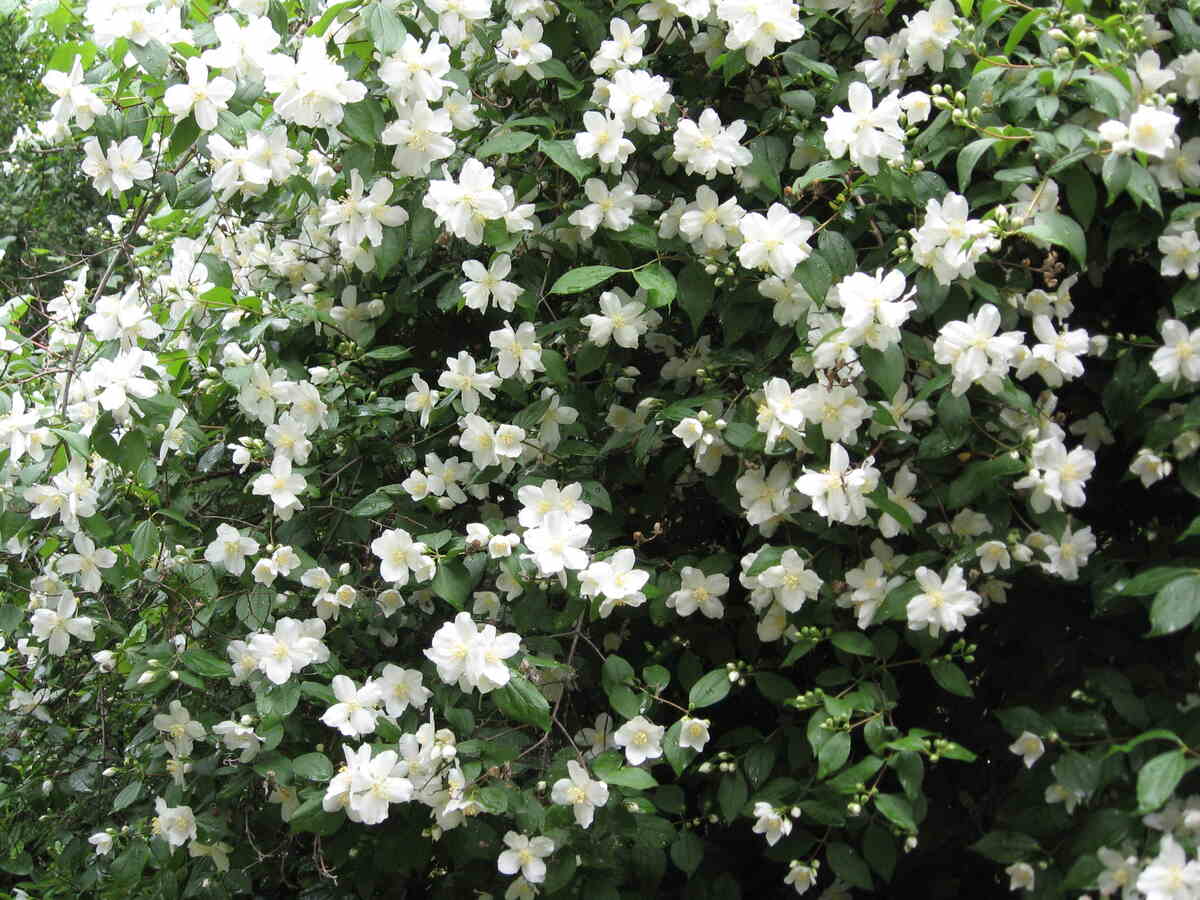
Born from and for the local climate, Idaho’s native plants need up to 90% less water than turfgrass. To homeowners’ delight, they also don’t require mowing and rarely ask for fertilizers and pesticides.
You can always count on Idaho’s native species to care for themselves, the land, and the valuable local pollinators. Like Idahoans, these natives are all about community and helping others.
Here are ten of the most popular native plants you can invite into your Idaho garden today. You’ll love the cheerful colors, unique textures, and delicious scents!
- 1. Arrowleaf Balsamroot (Balsamorhiza sagittata)
- 2. Blue Flax (Linum lewisii)
- 3. Lewis’ Mock Orange (Philadelphus lewisii)
- 4. Rubber Rabbitbrush (Ericameria nauseosa)
- 5. Redtwig Dogwood (Cornus sericea)
- 6. Rocky Mountain Maple (Acer glabrum)
- 7. Big Sagebrush (Artemisia tridentata)
- 8. Saskatoon Serviceberry (Amelanchier alnifolia)
- 9. Common Yarrow (Achillea millefolium)
- 10. Bluebunch Wheatgrass (Pseudoroegneria spicata)
- Benefits of Native Plants
- Where to Plant Natives in Your Idaho Yard
- FAQ
1. Arrowleaf Balsamroot (Balsamorhiza sagittata)
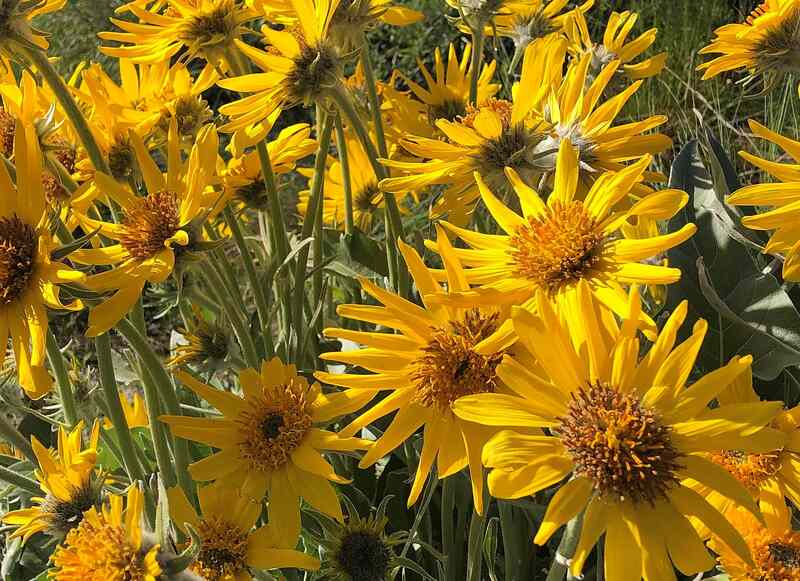
Arrowleaf balsamroot is popular along the trails of the Boise Foothills. It’s a showy plant that grows in mid to upper elevations in mixed conifer forest openings with Douglas fir and pinyon-juniper nearby.
Biologists say its presence is a sign of suitable habitats for the sage grouse, a beautiful bird native to the western US that the National Audubon Society reports is in the process of losing its natural habitats to development, invasive grasses, and wildfire.
Also known as the Oregon sunflower, arrowleaf balsamroot is the perfect plant for your garden’s arid areas and dry slopes. It develops deep, extensive taproots, stabilizing the soil, and has excellent drought tolerance.
All its parts are edible and have been used as food and medicine for centuries by Native Americans.
Note: It’s a slow grower and blooms after 2-3 years from seeding. Be patient. It’s worth it!
Type: Long-lived perennial wildflower.
Size: 1 to 2 feet tall
USDA hardiness zone: 4 to 8.
Soil: It prefers dry to moist, well-drained, silty to loamy soils, acidic to neutral (pH range of 6.5 to 8.0).
Light: Full sun, but also tolerates partial shade.
Drought tolerance: High.
Use in landscaping:
- In flower beds or as a border.
- Understory for taller shrubs and trees.
- Excellent for pollinator and butterfly gardens, cottage and wildflower gardens, and restoration projects.
Maintenance: Water it during dry spells to promote blooming.
Shop arrowleaf balsamroot seeds online:
2. Blue Flax (Linum lewisii)
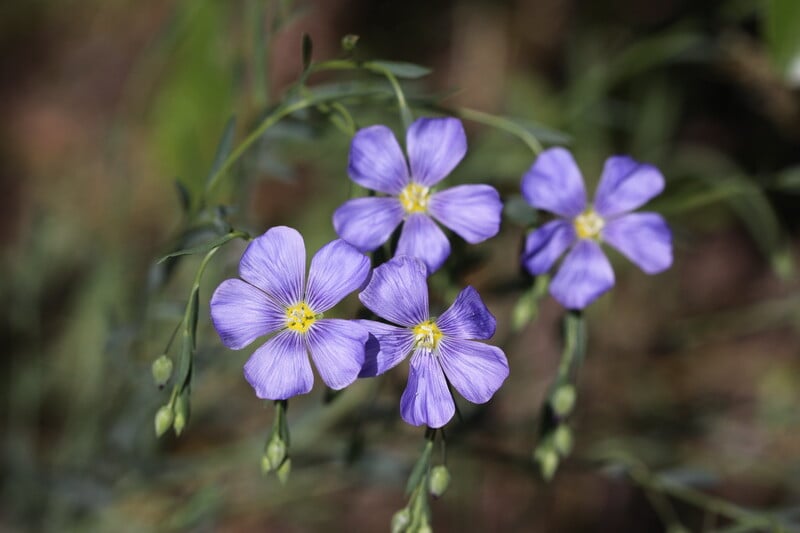
Blue flax is the perfect view to wake up to if you’re grumpy in the morning. It’s a cheerful shrub covered in friendly pale-blue flowers from May to July. They bloom on delicate, thin stalks that wave in the softest breeze, shine through the day, and fall off in the evening. The next morning, new buds open up to say, “Hi!”
Also known as Lewis flax or wild blue flax, it’s a vigorous plant native to the foothills and mountain meadows of the Western U.S. It doesn’t need much pampering. Plant it in a corner with full sun, and remember to water it during dry spells to keep it in full bloom. On the other hand, it enjoys the cooler areas of the state and might be less suitable for gardens in Bruneau and other southern Idaho cities.
Type: Annual or perennial wildflower.
Size: 12 to 30 inches tall and 8 to 18 inches wide.
USDA hardiness zone: 5 to 9.
Soil: It thrives in various soil conditions.
Light requirements: Full sun.
Drought tolerance: Moderate.
Use in landscaping:
- In flower beds, single, or in groups.
- In mountain meadow landscapes.
Maintenance: Cut back flower stalks when the flowering period ends.
Shop blue flax seeds online:
3. Lewis’ Mock Orange (Philadelphus lewisii)
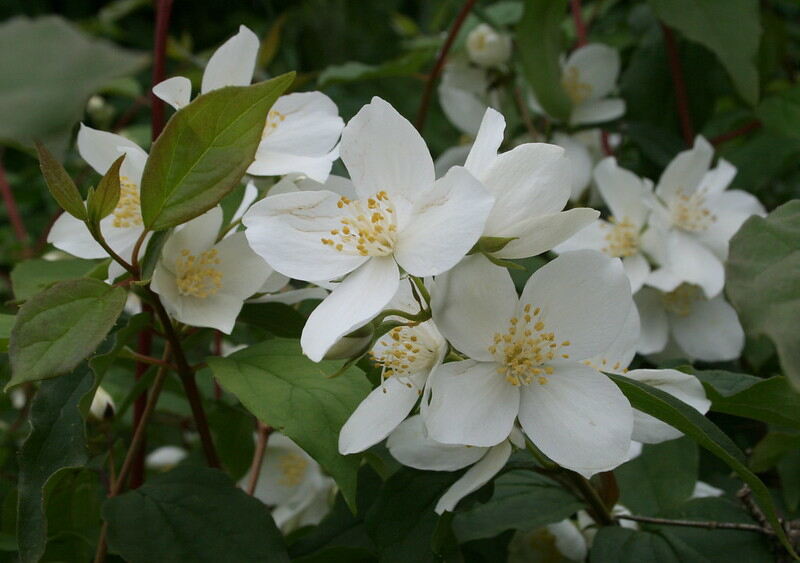
This beauty wins over all the green-thumbed folks in the Gem State in a second. It is no wonder it bears the title of Idaho’s state flower. The mock orange is covered in showy, delicate snow-white flowers resembling orange and lemon blossoms from May to June.
Mock orange flowers spread an intense, fresh, citrus-like scent. Find a place for them under your home windows, near a patio, or along walkways to enjoy its aroma.
It’s also a must-have in sensory gardens, along with the bitterbrush (Purshia tridentata) and nettleleaf giant hyssop (Agastache urticifolia).
Type: Deciduous shrub.
Size: 8 to 12 feet tall and 5 to 8 feet wide.
USDA hardiness zone: 4 to 8.
Soil: It tolerates a wide range of soils if drainage is good.
Light requirements: Full sun and part shade.
Drought tolerance: Moderate.
Use in landscaping:
- Accent plant or specimen in flower bed or border.
- Privacy screen.
- Near shrubs or small trees.
- Close to living or leisure areas where you can enjoy the fragrance.
- Best in less formal landscaping
Maintenance: Prune this flowering shrub periodically to create a rounded crown.
Shop mock orange (also known as Western Syringa) online:
4. Rubber Rabbitbrush (Ericameria nauseosa)
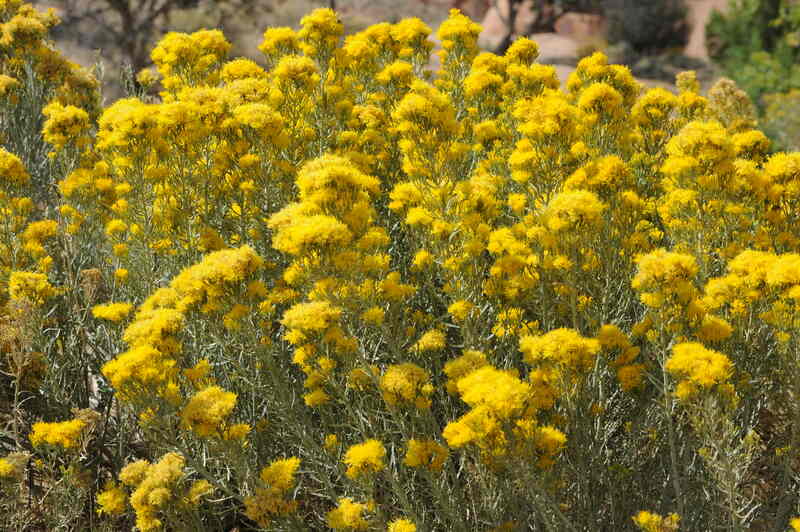
Have an arid, hot, bare spot in your yard? We bet the rabbitbrush can make it work! Its graceful silver leaves and fluffy flowers make it look delicate and fragile, but it’s one of the most hardy and drought-resistant native plant species in Idaho.
Rubber rabbitbrush is a treasure for the local ecosystem. Its tiny bright yellow flowers blooming in ball-like clusters are precious for local pollinators. Sometimes, hundreds of tiny insects fly off it. When this happens, it looks like the entire flower takes flight.
Type: Upright woody shrub.
Size: 3 to 5 feet tall and wide.
USDA hardiness zone: 4 to 9.
Soil: It thrives in well-drained, shallow, poor, or standard garden soil.
Light requirements: Full sun.
Drought tolerance: High.
Use in landscaping:
- Perfect for xeriscaping gardens and dry spots in your garden, exposed to heat and full sun.
- Plant it in pollinator gardens mixed with beardtongue (Penstemon spp.) with striking blue, lavender, and purple flowers, hummingbird mint (Agastache cana), butterfly milkweed (Asclepias tuberosa), beebalm (Monarda didyma), and Utah serviceberry (Amelanchier utahensis).
Maintenance: Cut it back to 6-12 inches in early spring to keep it compact and neat.
5. Redtwig Dogwood (Cornus sericea)
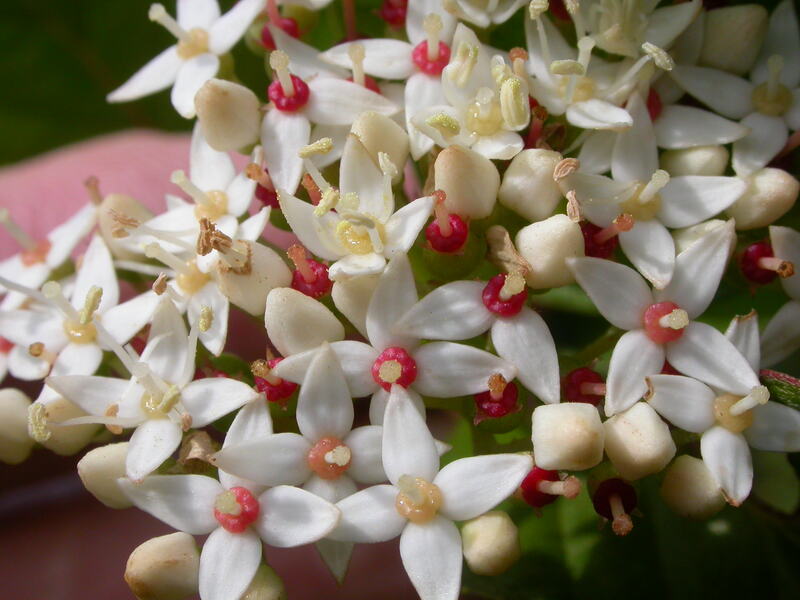
This dogwood keeps a low profile during spring and summer and only takes the stage in the fall. But, oh, boy! When it does, it’s all fireworks! The leaves turn a firey red all over its canopy as if the phoenix rose from its ashes and made a nest in your backyard. You can’t take your eyes off it!
Then the leaves fall. Its red branches remain in full view, making for a perfect winter accent plant. Your garden will never seem bare in the cold season again. While it’s a superstar, it doesn’t mind staying in the shade. It’s top of the list for understory options that look great under your garden’s shade trees.
Redtwig dogwood is also an invaluable support for local wildlife. It offers dense shelter and edible berries as food. Plant it in a low spot in your yard or as part of a rain garden.
Type: Deciduous shrub.
Size at maturity: 6 to 8 feet tall, over 12 feet wide.
USDA hardiness zone: 2 to 7.
Soil: Thrives in heavier soils with high water holding capacity.
Drought tolerance: Moderate. It grows best in consistently damp or regularly irrigated locations but can also tolerate drought with some minimal watering.
Light: Full sun to moderately heavy shade.
Use in landscaping:
- Privacy screen or low layer in windbreaks.
- Specimen plant.
- Understory for tall trees.
- It is a valuable addition to wildlife habitats, offering dense cover and edible berries for birds and small mammals.
Maintenance:
- Water every 10 to 14 days during hot summer months.
- Trim old branches occasionally.
- Prune in the spring to the desired size and shape (if you want a neat look).
Where to buy redtwig dogwood seeds and cuttings online:
6. Rocky Mountain Maple (Acer glabrum)
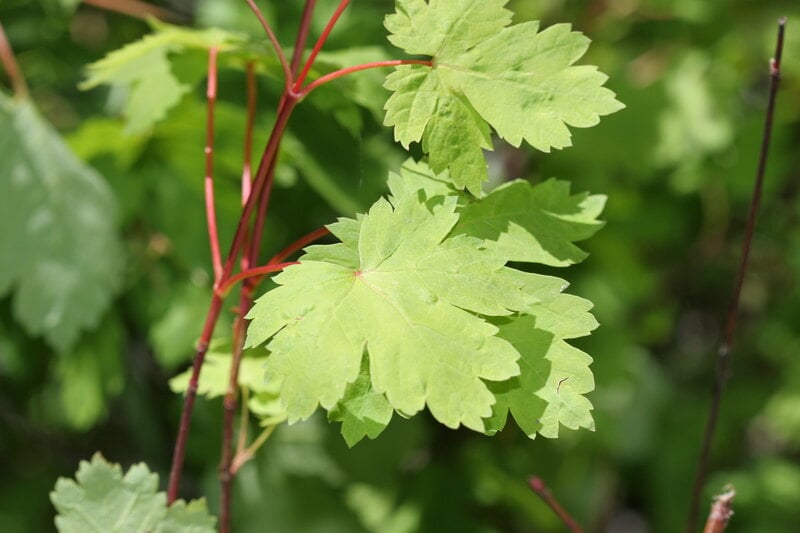
Also known by the common names of Douglas maple and rock maple, this shrub is not a huge presence but is undoubtedly a big head-turner.
The rocky mountain maple has impressive colors. It sprouts all red in the spring and hides under soft, green foliage in summer. In Autumn, its leaves turn an unusual bright yellow to dark pink-golden shade.
Acer glabrum naturally grows in wetlands and stream banks and needs extra water during dry spells. It’s also an excellent option for shaded gardens.
Type: Deciduous shrub or small tree.
Size at maturity: 15 to 30 feet tall and 8 to 15 feet wide.
USDA hardiness zone: 4 to 8.
Soil: Prefers deep, loamy, slightly acidic soil but tolerates alkaline.
Light: Grows in moderately deep shade to full sun. It thrives in moderately dry, shady sites.
Drought tolerance: Moderate to high.
Use in landscaping:
- Specimen tree.
- Understory for taller, larger trees.
Maintenance:
- Prune the young tree until you get the desired shape.
- Ensure some additional watering during drought.
7. Big Sagebrush (Artemisia tridentata)
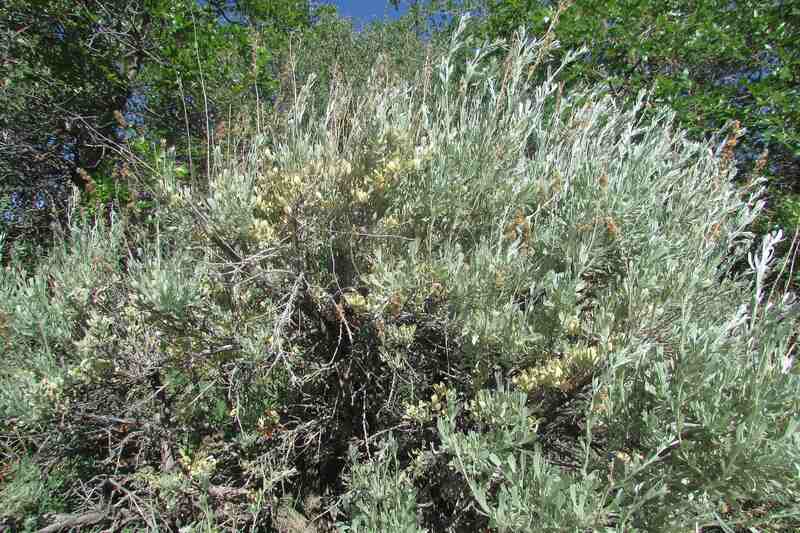
If you walk through a garden with big sagebrush during summer, you’ll catch a whiff of a clean, sharp winter smell that surprises you. It’s set free by the small silvery leaves growing on the shrub’s twisted branches. Some say it smells like Christmas with a twist of camphor.
Also known as the desert sagebrush, this shrub or small tree is native to the Great Basin region. Its charm and beauty are all in its foliage, making it an ideal backdrop for more showy plants. With excellent drought tolerance, it’s also perfect for xeriscaping and arid slopes. Once established, it thrives on rainfall alone.
Type: Evergreen shrub or small tree.
Size: 3 to 15 feet tall and 3 to 10 feet wide.
USDA hardiness zone: 4 to 9.
Soil: It thrives in well-drained, dry, sandy, loamy, or rocky soils.
Light: Full sun (very low shade tolerance).
Drought tolerance: High.
Use in landscaping:
- Plant as hedge, screen, or ground cover.
- In xeriscaping gardens, arid areas, and on slopes for soil stabilization.
Maintenance:
- Prune periodically to grow denser shrubs.
- After it establishes, you don’t need to irrigate it during summer. Wet soil exposes it to root rot.
Shop big sagebrush (dessert sagebrush) online:
8. Saskatoon Serviceberry (Amelanchier alnifolia)
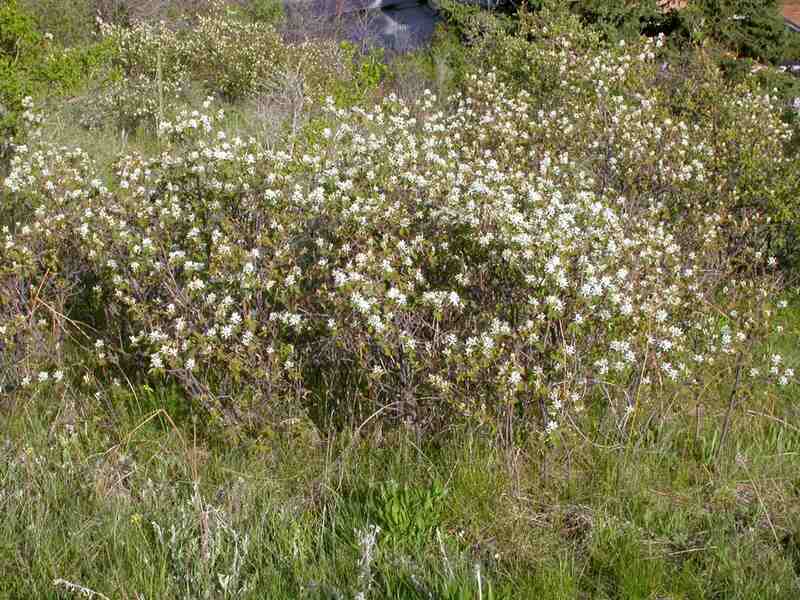
Got a sweet spot in your yard? Plant serviceberry! It’s a little-known way to get loads of healthy and yummy fruits for your family. It produces light red to dark purple or blue pomes, which are like tiny apples (they’re not real berries, despite the shrub’s name).
When you munch on them, it’s like a cherry and blueberry mix with a surprise marzipan twist from the seeds! You can enjoy its fresh fruits or use them in mouth-watering jams, pies, jellies, and other desserts.
The serviceberry is also a showy shrub. From April to May, it’s covered in brilliant white flowers. When fall rolls in, its leaves transform into a dazzling display of oranges and reds.
Type: Deciduous shrub.
Size at maturity: 3 to 15 feet.
USDA hardiness zone: 4 to 7.
Soil: Tolerates various soil conditions, including alkalinity. It’s less tolerant to salty and wet terrains.
Light: Full sun, but tolerates partial shade.
Use in landscaping:
- In privacy screens, borders.
- In mixed beds or open spaces.
- To fill areas around deciduous and evergreen trees.
Maintenance:
- Moderately drought tolerant. It needs some water during the summer to ensure high-quality fruits.
- Prune to keep the desired form and size.
Shop serviceberry seeds and trees online:
9. Common Yarrow (Achillea millefolium)
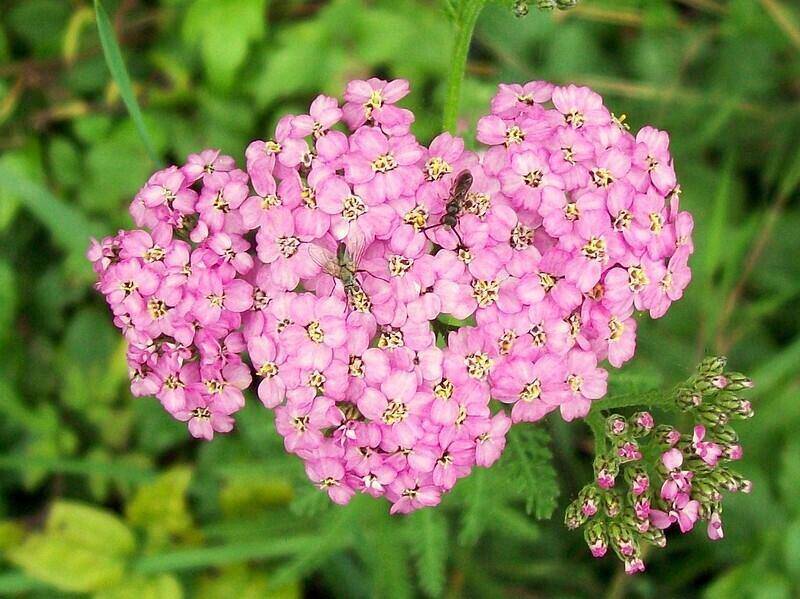
Common yarrow has upright, sturdy stems covered in hundreds of small, feathery leaves. The flat-topped, dome-like flowers are made of dozens of daisy-like florets. Their colors vary from white and pink to deep red shades.
When bruised, the leaves and flowers release a spicy scent. It feels like an Italian cooking herb mix with notes of oregano and basil. Yarrow is also a magnet for beneficial insects, ideal for wildlife habitats and butterfly gardens.
Type: Perennial herb.
Size: 3 feet tall.
USDA hardiness zone: 4 to 6
Soil: It prefers loamy, well-drained, slightly acidic soil.
Light: Full sun. In partial sun tends to get leggy.
Drought tolerance: High.
Use in landscaping:
- As ground cover and alternative to turfgrass in dry areas.
- Part of pollinator and butterfly gardens and meadows.
- Plant in outdoor containers.
Maintenance:
- Water only until it establishes.
- Fertilization is rarely needed and can do more harm than good.
- Remove dead stems in the center of the clump in the spring.
- Divide the plant every 3 to 5 years to ensure healthy growth.
Where to buy yarrow seeds online:
10. Bluebunch Wheatgrass (Pseudoroegneria spicata)
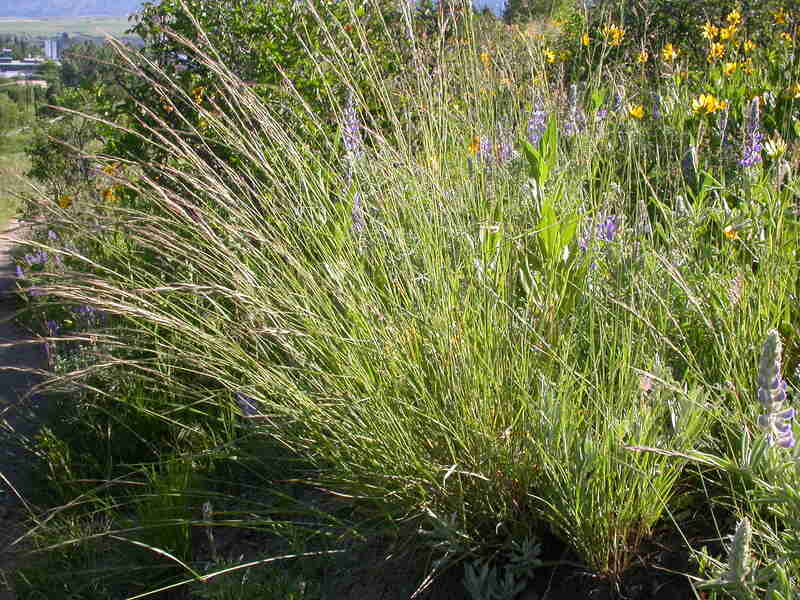
Bluebunch wheatgrass is a precious food source for local wildlife. With roots digging up to 6 feet into the soil, this native grass keeps green and feeds hungry animals during droughts.
It’s a gracious green clumping grass that grows up to 4 feet tall and adds color to arid areas in your yard. Consider it for a xeriscape, desert, or rock garden.
Wheatgrass is also a good solution for any dry zone in your yard where you can’t grow the popular Idaho turfgrasses.
Type: Perennial cool-season native grass.
Size: 1.6 to 4 feet tall.
USDA hardiness zone: 3 to 7.
Soil: It thrives in well-drained soils.
Light: Full sun to partial shade.
Drought tolerance: High.
Use in landscaping:
- Ground cover with other slow-growing plants like bug sagebrush, Idaho fescue, and ponderosa pine.
- Install it on sloped areas for soil stabilization.
Maintenance: It’s a slow-growing grass, less able to keep weeds away while growing. You’ll need to ensure they don’t overwhelm it.
Shop bluebunch wheatgrass seed online:
Benefits of Native Plants
Adding native species to your landscape brings unique and valuable benefits ranging from aesthetics and local pride to environmental and financial considerations. Here are the main benefits of including native plants in your landscape:
- With the right plants, you can have a stunning, unique-looking garden.
- Lower water bills. Plants native to the Intermountain West region use less water than imported ones. Some natives thrive with only 3 to 5 waterings a year.
- You spend less time, money, and energy on yard maintenance. Natives need less to no fertilizer, pesticides, and herbicides.
- The garden becomes a valuable pillar of environmental protection. Native plants feed and shelter pollinators, which are essential for the local ecosystem.
- Using native plants instead of imported ones prevents the introduction of invasive plants. Imported species don’t help the local wildlife much and often prove difficult to control. They can also overpower native plants, potentially destroying ecosystems.
- They convert the yard into a friendly wildlife habitat for insects, birds, and small animals that keep away pests.
- You get to be a part of preserving Idaho’s remarkable natural heritage.
Where to Plant Natives in Your Idaho Yard
The secret to integrating natives into your garden is to take it one step at a time. Look at your outdoor space and find suitable places to create wild corners. Here are a few options you might identify:
Open Spaces That Can Use Some Color, Texture, and Shade
The basic example is a yard covered entirely with turfgrass. It’s the perfect place to add trees and shrubs.
Some native plants you can use are rocky mountain juniper (for dry areas), water birch (for dry and moist soils), pinyon pine, and limber pine.
Shaded Areas Under Trees and Near the House
Most turfgrasses and exotics don’t do so well in the shade. But there are some beautiful native ground covers and shrubs you can use to fill the areas under and around trees.
Some good examples are the following:
- Bellflower (Campanula rotundifolia)
- Golden currant (Ribes aureum)
- Creeping Oregon grape (Mahonia repens)
- Pinewoods geranium (Geranium caespitosum)
- Columbine (Aquilegia spp.)
- Western sword fern (Polystichum munitum)
- Whipple’s penstemon (Penstemon whippleanus)
Dry Corners or Edges
We all have some dry corners or edges where the sprinklers won’t reach and the grass won’t stay green. Adding native wildflowers, shrubs, and trees is an excellent way to make those sparse areas look beautiful while lowering water bills.
Some drought-tolerant native plants for Idaho are:
- Bristlecone pine (Pinus aristata)
- Ninebark (Physocarpus capitatus)
- Oak-leaf sumac (Rhus trilobata)
- Colorado aster (Aster coloradoensis)
- Desert four o’clock (Mirabilis multiflora)
- Arrowleaf buckwheat (Eriogonum compositum)
Steep Slopes
Steep areas make it difficult to irrigate the soil properly and are often exposed to erosion. If you have a steep slope in your yard, consider planting drought-tolerant natives and converting it into a rock garden.
Here are a few Idaho native wildflowers and grasses that look stunning among stones:
- Beardtongue (Penstemon spp.)
- Cutleaf daisy (Erigeron compositus)
- Cushion phlox (Phlox kelseyi)
- Blue fescue (Festuca idahoensis)
Roadside Strips
Planter strips are some of the most difficult areas to keep green with classic turfgrass. The small size makes them hard to mow and irrigate, and the high heat makes the grass vulnerable to pests.
For successful planting on roadside strips, you’ll need native plants that are resilient to heat, full sun, and drought, such as:
- Desert fernbush (Chamaebatiaria millefolium)
- Lacy buckwheat (Eriogonum corymbosum)
- Dwarf yucca (Yucca nana)
- Rocky Mountain penstemon (Penstemon strictus)
- Desert zinnia (Zinnia grandiflora)
FAQ About Idaho Native Plants
Some beautiful native species that grow up in north Idaho are the Douglas fir, Engelmann spruce, subalpine fir, ponderosa pine, western red cedar, red elderberry, ninebark, and serviceberry.
Yes, sagebrush is native to the Gem State. It’s a common view in the Snake River Plane in Southern Idaho.
Yes, lots of native species can be propagated using their seeds. But, some need to be treated through stratification or scarification to germinate properly.
If you want to create a garden with both a traditional lawn and native plants, the best time to seed cool-season grass in Idaho is late August to early September.
Fill Your Yard with Native Gems Today!
With stunning colors, shapes, and textures, Idaho’s native plants make gardens look more beautiful than ever. They’re also low-maintenance, good for the soil, and a blessing for local pollinators. Choose yours today!
Contact a landscaping company in Idaho to get help filling your yard with local gems! LawnStarter can put you in touch with the best experts in Boise, Rexburg, Couer d’Alene, and all over the state.
Main Image Credit: A. Barra / Wikimedia Commons / CC BY-SA 4.0